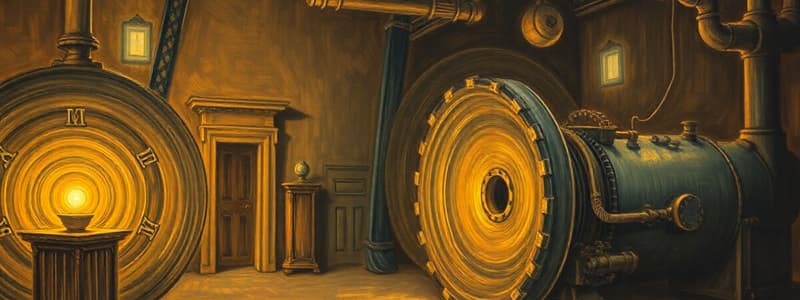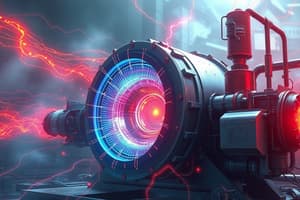Podcast
Questions and Answers
In an AC generator, what is the primary function of the slip ring or twin-ring commutator?
In an AC generator, what is the primary function of the slip ring or twin-ring commutator?
- To convert AC to DC
- To allow the current to be extracted from the rotating coil (correct)
- To increase the magnetic field strength
- To regulate the speed of the rotating coil
What structural modification is required to convert a simple AC generator into a simple DC generator?
What structural modification is required to convert a simple AC generator into a simple DC generator?
- Reversing the polarity of the magnets
- Replacing the slip rings with a commutator (correct)
- Replacing the electromagnet with a permanent magnet
- Increasing the number of coils in the generator
In a DC generator, why is it crucial for commutation (the switch between commutator segments) to occur when the coil is approximately perpendicular to the magnetic field?
In a DC generator, why is it crucial for commutation (the switch between commutator segments) to occur when the coil is approximately perpendicular to the magnetic field?
- To reduce the mechanical stress on the generator.
- To minimize sparking between the brushes and commutator.
- To ensure the current maintains its direction in the external circuit. (correct)
- To maximize the induced EMF at the moment of switching.
An AC generator with a coil rotating at a constant speed produces an alternating voltage. If the speed of rotation of the coil is doubled, what is the effect on the frequency and amplitude of the output voltage?
An AC generator with a coil rotating at a constant speed produces an alternating voltage. If the speed of rotation of the coil is doubled, what is the effect on the frequency and amplitude of the output voltage?
A small direct current generator that uses a split-ring commutator is connected to power a light bulb. If the commutator becomes misaligned, what is the most likely symptom that would be observed?
A small direct current generator that uses a split-ring commutator is connected to power a light bulb. If the commutator becomes misaligned, what is the most likely symptom that would be observed?
Flashcards
AC Generator (Alternator)
AC Generator (Alternator)
A generator that produces alternating current. A coil rotates within a magnetic field, inducing an alternating voltage.
Slip Ring Commutator
Slip Ring Commutator
A device used in AC generators to extract current from the rotating coil.
DC Generator
DC Generator
A generator that produces direct current. It uses a commutator to convert AC voltage to DC voltage.
Commutator (in DC Generator)
Commutator (in DC Generator)
Signup and view all the flashcards
Commutation Point
Commutation Point
Signup and view all the flashcards
Study Notes
- Electric generators are likely the most important application of electromagnetic induction
- The principle of alternating current generators has been previously discussed
- A coil rotates near the poles of a magnet or electromagnet to generate alternating current in the coil
- The current exits the rotating coil through a twin-ring or slip-ring commutator
- An AC generator can be modified into a DC generator by replacing slip rings with a commutator like in DC motors
- The two brushes are arranged so that contact exchanges as the coil passes through the vertical
- The electromotive force (EMF) induced in the coil reverses every half cycle
- One brush remains positive while the other stays negative
- Induced current flows without changing direction over time
- AC converts to DC when commuting occurs after the loop is perpendicular to the field
Studying That Suits You
Use AI to generate personalized quizzes and flashcards to suit your learning preferences.




